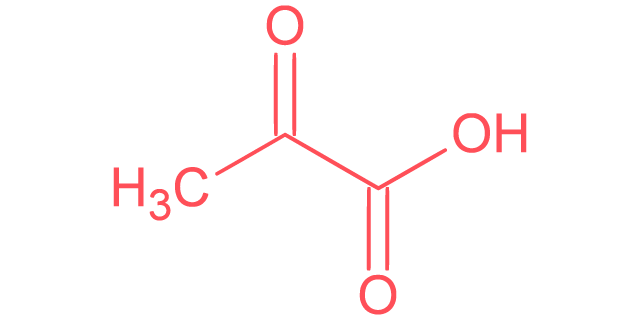Pyruvic Acid

Linear Formula
C3H4O3
Synonyms
2-oxopropanoic acid, acetoic acid, acetylformic acid, α-Ketopropionic acid
Share this metabolite
Pyruvic acid is the simplest alpha-keto organic acid, containing a carboxylic acid group and a ketone functional group. Originally named pyroracemic acid, it was first prepared in the lab by dry distillation of tartaric acid. Its physical properties include being a colorless liquid with an odor reminiscent of vinegar, and it is soluble in both water and organic solvents.
Pyruvic acid is the conjugate acid of pyruvate, which is the end product of glycolysis. Pyruvic acid has a prominent role in several key metabolic processes; its role in sugar metabolism enables the breakdown and synthesis of sugars, fatty acids, and amino acids, the building blocks of proteins.
Pyruvate itself is the substrate for several enzymes whose dysfunction presents major implications for human health. For example, in many cancer cells, the typical isoform of the enzyme pyruvate kinase is supplanted by an embryonic form that alters sugar metabolism in a condition called the Warburg Effect.1 When the eponymous enzyme of the pyruvate dehydrogenase complex is missing or compromised, the result is severe metabolic dysfunction and brain malformations,2 reflecting the brain’s high demand for glucose metabolism.
Pyruvic Acid and Glycolysis
Pyruvic acid plays a central role in glycolysis, the oxidation of sugar that occurs in nearly all living cells. In glycolysis, one molecule of glucose, a sugar with six carbon atoms, is split into two molecules of pyruvate, a compound with three carbon atoms. This reaction generates energy in the form of two ATP molecules.
Glycolysis occurs in both aerobic and anaerobic states. During aerobic respiration, pyruvate is converted into carbon dioxide plus a two-carbon acetyl group that attaches to coenzyme-A (CoA) to form acetyl-CoA. Acetyl-CoA then enters the tricarboxylic acid cycle (TCA cycle, citric acid cycle, or Krebs cycle) and undergoes oxidative phosphorylation, whereby it is converted to acetaldehyde.
When insufficient oxygen is present, pyruvate is converted by fermentation to lactate via the action of lactate dehydrogenase. This process contributes to lactic acidosis, the lactic acid buildup in the bloodstream that occurs when oxygen levels are low in energy-producing cells (i.e., during periods of intense exercise).
Pyruvic Acid and Wine Production
Its role in alcoholic fermentation—the process of converting sugar into alcohol using yeast—gives pyruvic acid a central role in winemaking and wine quality. Adding pyruvic acid, which is fermented by Saccharomyces yeast strains used in winemaking, has been shown to increase levels of the anthocyanin vitisin A, a compound responsible for the pigmentation of red wine.3 Others have reported differing pyruvic acid levels across different types of wine, and levels of this molecule in the final product can be significantly impacted by both yeast strains and temperature during fermentation.4
Pyruvic Acid and Skin Health
Clinical trials show that pyruvic acid is an effective treatment for acne when it is administered in a series of chemical peels.5 It gained attention because of its keratolytic, antimicrobial, and sebostatic properties, as well as its ability to stimulate collagen and elastic fiber formation6. In clinical trials, pyruvic acid peels significantly reduced the number of skin lesions and oiliness. Despite production of irritating vapors and temporary burning sensations, researchers concluded that pyruvic acid peels are a safe and beneficial intervention.5
Pyruvic Acid and Brain Health
It is hypothesized that pyruvic acid has a protective effect against neuronal cell death induced by various stresses, such as ethanol toxicity or excessive release of Zn2+ as is seen during stroke. Preliminary in vitro studies suggest the mechanism involves suppression of the mitochondrial injury caused by cytochrome c release. Additionally, pyruvic acid was shown to prevent Cu2+/Zn2+-induced death of neuronal cells in culture.7
Indole-3-pyruvic acid (IPA), a precursor to the amino acid tryptophan, has been investigated as a treatment for anxiety and insomnia, due to its ability to increase serotonin turnover in the CNS and melatonin turnover in the pineal gland. Several small pilot clinical trials found that administration of IPA could improve mood and increase sleep time.8 Larger study results have not yet been reported.
Pyruvic Acid and the Gut Microbiome
The gut microbiome contributes significantly to energy metabolism. Both pyruvic acid and tricarboxylic acid are reduced in the serum of germ-free (GF) mice. Genes involved in the TCA cycle and metabolism of pyruvate are also reduced in GF mice. In obese/insulin-resistant patients, pyruvic acid levels can be high after glucose consumption, suggesting inefficient transit into the TCA cycle. Weight loss has been shown to reverse this trend and alter gut microbiome composition as judged by increases in bacterial metabolites. All these changes are thought to converge on increased metabolic efficiency.9
Gut bacteria also contribute to the production of indole-conjugated metabolites, including IPA.10 The aryl hydrocarbon receptor (AHR) is a ligand-activated transcription factor that plays an important role in maintaining homeostasis in the intestinal mucosa. IPA is a precursor of AHR agonists produced by gut bacteria, which can suppress intestinal inflammation in mouse models of inflammatory bowel disease (IBD). IPA’s anti-inflammatory effect significantly suppressed experimental colitis in a mouse model of IBD.11
Pyruvic Acid in Research
As of July 2023, there are over 600 citations for “pyruvic acid” in research publications (*excluding books and documents) on PubMed. The extensive number of publications linking pyruvic acid to sugar metabolism and other diverse catabolic and anabolic cellular processes indicate that this is a metabolite of great interest. Any researcher interested in the vast number of health conditions related to these activities should consider including quantitative analyses of pyruvic acid in their study.
References
- Gray LR, Tompkins SC, and Taylor EB. Regulation of pyruvate metabolism and human disease. Cell Mol Life Sci 2014;71(14):2577-2604.
- Ebertowska A, Ludkiewicz B, Morys J, et al. Pyruvate dehydrogenase deficiency: morphological and metabolic effects, creation of animal model to search for curative treatment. Folia Morphol (Warsz) 2020;79(2):191-197.
- Chilicka K, Rogowska AM, Taradaj J, et al. A comparison of the effectiveness of azelaic and pyruvic acid peels in the treatment of female adult acne: a randomized controlled trial. Sci Rep 2020;10(1):12612.
- Morata A, Calderón F, González MC et al. Formation of the highly stable pyranoanthocyanins (vitisins A and B) in red wines by the addition of pyruvic acid and acetaldehyde. Food Chemistry 2007;100(3):1144-52.
- Rankine BC. Factors influencing the pyruvic acid content of wines. J Sci Food Agric 1965;16(7):394-98.
- Kontochristopoulos G, and Platsidaki E. Chemical peels in active acne and acne scars. Clin Dermatol 2017;35(2):179-182.
- Tanaka KI, Shimoda M, and Kawahara M. Pyruvic acid prevents Cu(2+)/Zn(2+)-induced neurotoxicity by suppressing mitochondrial injury. Biochem Biophys Res Commun 2018;495(1):1335-1341.
- Politi V, De Luca G, Comin M, et al. Clinical experiences with the use of indole-3-pyruvic acid. Adv Exp Med Biol 1999;467:227-232.
- Campbell C, Grapov D, Adams SH, et al. Improved metabolic health alters host metabolism in parallel with changes in systemic xeno-metabolites of gut origin. PLoS One 2014;9(1):e84260.
- Velagapudi VR, Hezaveh R, Backhed F, et al. The gut microbiota modulates host energy and lipid metabolism in mice. J Lipid Res 2010;51(5):1101-1112.
- Aoki R, Aoki-Yoshida A, Takayama Y, et al. Indole-3-Pyruvic Acid, an Aryl Hydrocarbon Receptor Activator, Suppresses Experimental Colitis in Mice. J Immunol 2018;201(12):3683-3693.

